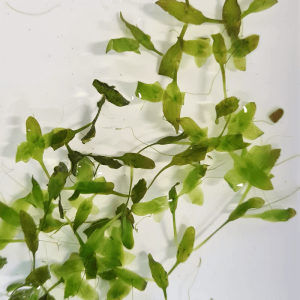Home " Oxygen plants " Point Rose
TL;DR | Pointweed (Lemna trisulca) is a native free-floating oxygen plant that lives just below the water surface. This transparent green aquatic plant contributes to a clear pond environment by competing with algae for nutrients. Pointed rose is hardy, low-maintenance and ideal for nature-friendly ponds.
Easily order Point Rose through our partner: Ordering pointed rose from Pond Master.
Pointed duckweed is a special species of duckweed that floats below the water surface, unlike other duckweed species that only float on top. The plant has lanceolate, translucent green discs that are about 0.5 cm in size. Thanks to this unique growth shape, Pointed Rose provides shade in the water without completely covering the surface. This prevents excessive light blockage for other aquatic plants.
Pointweed belongs to the family of duckweed plants and is completely free-floating. It does not root, but floats independently in the water column. This makes it very suitable for ponds up to about 60 cm deep.
Order easily via our partner: Ordering pointed rose from Pond Master.
This oxygen plant occurs naturally in stagnant or slow-flowing waters such as pools, ditches, polders and forest ponds. Pointweed does well in slightly shaded to sunny conditions and prefers moderately nutrient-rich, neutral to alkaline water. Stable water quality without large amounts of silt or pollution promotes healthy growth.
Pointweed is very effective in promoting a clear pond environment. As the plant absorbs nutrients from the water, fewer nutrients remain for algae. This greatly reduces the likelihood of algal blooms.
In addition, Pointweed produces oxygen and its floating mass provides a cooling effect on the water. In autumn, the plant sinks to the bottom, where it hibernates, before resurfacing in spring.
Pointweed is easy to maintain. For good performance, planting of about 4 litres per 1,000 litres of pond water is recommended. This may seem a lot, but it ensures maximum effectiveness against algae growth and encourages rapid establishment.
The plant has no roots and therefore does not need to be placed in pond baskets. If desired, excess plant material can be removed manually in summer. Poinsettia is hardy to -25 °C and even stays green in mild winters.
Unlike other species of duckweed, such as Small duckweed (Lemna minor), Pointweed grows below the water surface. It sometimes forms small networks of discs that stay connected. This creates a cloud-like effect in the water.
The plant rarely flowers, but when it does, the flowering parts surface briefly. Seed formation is uncommon, however; Pointweed spreads mainly vegetatively.
Pointweed provides a hiding place for small aquatic animals such as water fleas and young fish. It also contributes to water quality by absorbing nutrients from the water and adding oxygen. In combination with other plants, it creates a stable pond ecosystem.
This plant is perfect for ecological and low-maintenance ponds. Thanks to its low height and subtle appearance, Pointed Rose is visually less dominant than other floating plants. This preserves the natural appearance of the pond.
For optimum performance, Puntkroos can be combined with other oxygen plants as Glossy pondweed or Hornleaf.

Puntkroos can be ordered through our sales partner Vijvermeester.nl.
Zuurstofplanten.net is a website of Dutch Water Tech. Specialist in water treatment for municipalities and water boards. Would you like to know more? Visit dutchwatertech.co.uk for more information on our projects.
Dutch Water Tech BV
Gateway 1
4613 BW Bergen op Zoom
You can buy oxygen plants, bank plants and other pond products through our partner Vijvermeester.nl.
© 2025 Dutch Water Tech. All rights reserved.